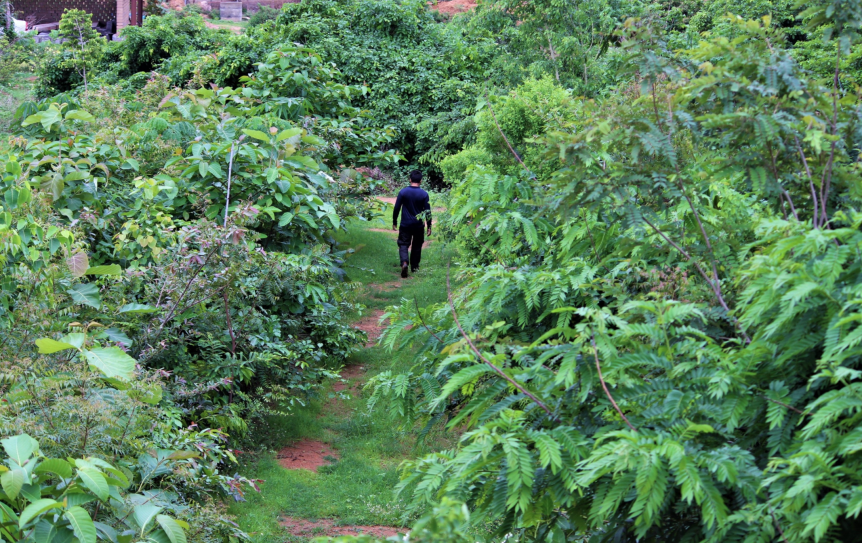Imagine a forest. You’re probably picturing a vast, sprawling woodland, the kind you could get lost in for days. Now, imagine that same dense, biodiverse ecosystem—but packed into a space the size of a tennis court. It sounds like magic, but it’s a very real and revolutionary gardening method taking the world by storm: the Miyawaki Forest.
Named after its creator, the renowned Japanese botanist Dr. Akira Miyawaki, this technique isn’t just about planting trees; it’s about engineering an entire ecosystem from the ground up. And it’s proving to be a powerful tool in the fight against climate change and biodiversity loss, especially in our urban spaces.
So, what exactly makes a Miyawaki Forest so special?
The Genius Behind the Method: Dr. Akira Miyawaki
In the 1970s, Dr. Miyawaki was tasked with restoring native forests on degraded land in Japan. He observed that the protected areas around temples and shrines contained lush, multi-layered, and resilient native forests. These were the “potential natural vegetation” of the area—the plant communities that would thrive there if left undisturbed.
His breakthrough was developing a method to jump-start this natural succession process, which normally takes centuries, compressing it into just a few decades.
The Miyawaki Method: A Recipe for an Instant Forest
The magic of the Miyawaki method lies in its meticulous, science-based approach. It’s not a random act of planting; it’s a carefully choreographed process:
-
Soil Assessment and Preparation: Before a single sapling goes in the ground, the soil is analyzed and enriched. This isn’t about chemical fertilizers. Instead, local organic matter—like compost, straw, or manure—is mixed in to create a rich, spongy, and water-retentive base. This mimics the nutrient-rich forest floor.
-
Native Species Selection: This is the heart of the method. Dozens of native plant species are carefully selected to recreate the area’s “potential natural vegetation.” The key is biodiversity. A typical Miyawaki plot will include a mix of:
-
Canopy Trees (the tallest)
-
Tree Sub-layer (medium height)
-
Shrubs
-
Groundcover
This creates a multi-layered, vertical forest that maximizes photosynthesis and habitat.
-
-
Dense, Random Planting: Saplings are planted incredibly densely—about 3 to 4 per square meter. This is the opposite of conventional forestry. Why so close? It forces the plants to compete for sunlight, driving them to grow upwards, not outwards. This rapid vertical growth is the secret to the method’s speed. The planting is also random, mimicking the chaos of nature, not the orderly rows of a plantation.
-
Mulching and Initial Care: The area is thickly mulched with straw or other biomass to suppress weeds, retain moisture, and continue feeding the soil. The forest is then watered and weeded for the first 2-3 years, after which it becomes entirely self-sustaining.
Why the Hype? The Incredible Benefits of Mini-Forests
The results of this intensive process are nothing short of astonishing:
-
Super-Fast Growth: Miyawaki Forests grow 10 times faster than a conventional plantation. Within just a year, it’s a thicket. In three years, it’s a self-sustaining young forest.
-
30 Times More Dense: The dense planting creates a thick canopy that shades the ground, preventing weeds and creating a complex habitat.
-
30 Times Better Noise and Dust Reduction: The multi-layered vegetation acts as a superb natural sound barrier and air filter.
-
Superior Carbon Sequestration: A young, fast-growing forest with high biodiversity absorbs far more carbon dioxide than a monoculture plantation.
-
Biodiversity Hotspots: These forests become bustling hubs for local wildlife—birds, butterflies, insects, and small mammals—in a very short time.
-
Urban Oases: They lower the “Urban Heat Island” effect, naturally cool the air, manage stormwater runoff, and provide precious green spaces for community well-being.
The Miyawaki Movement: From Backyards to Cities
What started in Japan has become a global movement. From India and Europe to Latin America and the United States, communities, schools, and corporations are transforming forgotten plots of land—roadside verges, schoolyards, factory perimeters, and urban wastelands—into thriving native forests.
It’s a powerful, tangible action that anyone can get involved in, proving that you don’t need thousands of acres to make a difference. Sometimes, a tiny forest can have the mightiest impact of all.
Inspired to grow your own?
Start by researching the native trees and shrubs in your area. Connect with local environmental groups—chances are, a Miyawaki project is already sprouting up near you.
The future of our planet might just be a tiny, mighty, and very dense forest.
